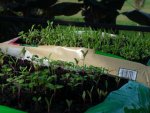I used shade cloth on my tomatoes the year I tried to grow them here in Austin. It didn't help. The nights weren't cool enough (77° avg at night; 100° or more during the day) to allow the blooms to set into fruit, and the ones that did set split when they started to ripen because I had to water the plants every day to keep them from dying. Those who have never lived down here don't know how hostile a climate it is for gardens.
(Cactus grows very well down here however.)
I gave up trying to grow tomatoes in the south. The first 5 years here, I learned NOTHING I knew about gardening in Oregon would survive this place. ....
Now 18 years into it, I grow food that thrives in hot sand. Pineapples = harvest 22 of them this year, ( from re-growing the tops of store-boughts. ) Avacados = had more than we could eat, but were able to give lots away..... Bananas = yep.... Guavas... yep.... Muscadines, Asparagus, Lemons, Pomegranates.
The fun part is keeping the squirrels away. (Haven't figured that out yet) My kiwi have vines, but haven't produced.
Broccoli does well in the winter. Rosemary grows like crazy. Started an Olive tree; we'll see on that.
So now the greens. They melt in the summer here, and I liked the idea of OP, to have a small, easy from the back door in winter salad bed.
Got it done. It's on a lanai table.
Seeds: Arugula, Perpetual Swiss Chard, Spinach, and Mesclun mix. Everything germinated within 2 days, and I like the tall tubs. If we have a freeze, will toss a garden blanket over the table.





